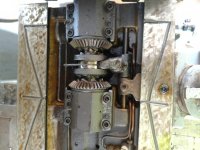thebencarter
Aluminum
- Joined
- Aug 23, 2017
VN faithful,
Over the past few months I've been going over my "new" 1R3-22 to verify everything is working properly and all set to last another 55+ years. One thing I am stumped on is a one-shot oiler point for the table feed mechanism is broken off; it's adjacent to the bevel gears and has no obvious bearing block or feed nut nearby. Here is a picture:

I bought 2mm copper refrigeration tube which I can solder to the distribution tubing to replace what was broken off, but I'd like to know what the factory setup was. Has anyone had their table off and seen this area? I was able to access it without pulling the entire table by removing the table feed screw, right hand end bracket and running the table partway off the dovetails (free end supported by a crane).
One other thing I'm puzzling over is I believe these bevel gears are supposed to run in an oil bath - at least, they did on older VNs. The saddle casting in that area forms a tub of sorts, but any oil added slowly runs through the vertical bevel gear's bearings and down into the feed transmission. I am fortunate enough to have a quality paper manual for the machine, and I don't see an oil seal on that shaft in the parts drawings; they are clearly called out in other places (such as the feed transmission shafts). Given this, I'm confused; perhaps the broken one shot oil point was to oil all three gears and the shifter mechanism, but that doesn't seem like enough oil to me. I am curious to know if anyone knows how these gears are lubricated.
Thanks in advance,
Ben
Over the past few months I've been going over my "new" 1R3-22 to verify everything is working properly and all set to last another 55+ years. One thing I am stumped on is a one-shot oiler point for the table feed mechanism is broken off; it's adjacent to the bevel gears and has no obvious bearing block or feed nut nearby. Here is a picture:

I bought 2mm copper refrigeration tube which I can solder to the distribution tubing to replace what was broken off, but I'd like to know what the factory setup was. Has anyone had their table off and seen this area? I was able to access it without pulling the entire table by removing the table feed screw, right hand end bracket and running the table partway off the dovetails (free end supported by a crane).
One other thing I'm puzzling over is I believe these bevel gears are supposed to run in an oil bath - at least, they did on older VNs. The saddle casting in that area forms a tub of sorts, but any oil added slowly runs through the vertical bevel gear's bearings and down into the feed transmission. I am fortunate enough to have a quality paper manual for the machine, and I don't see an oil seal on that shaft in the parts drawings; they are clearly called out in other places (such as the feed transmission shafts). Given this, I'm confused; perhaps the broken one shot oil point was to oil all three gears and the shifter mechanism, but that doesn't seem like enough oil to me. I am curious to know if anyone knows how these gears are lubricated.
Thanks in advance,
Ben




